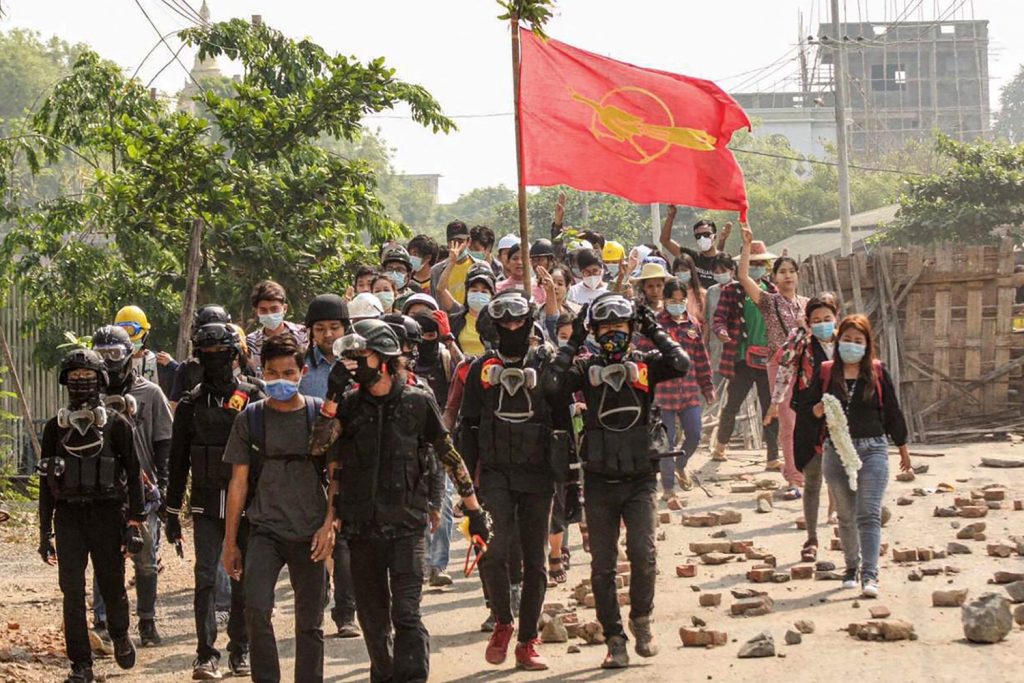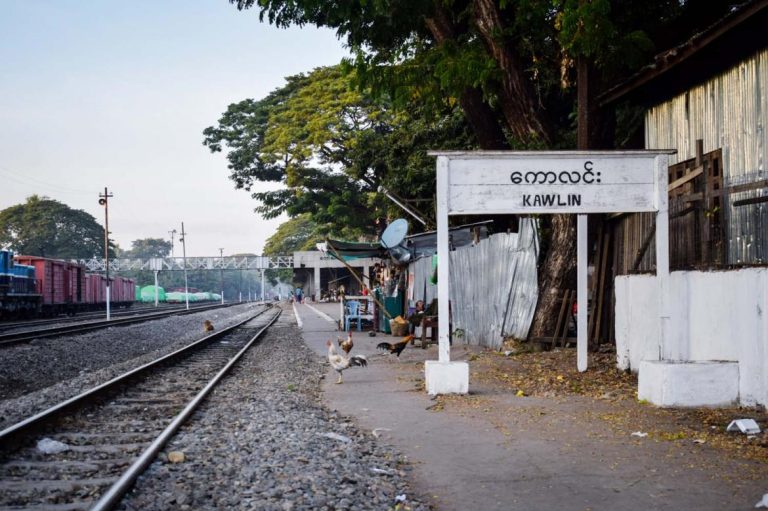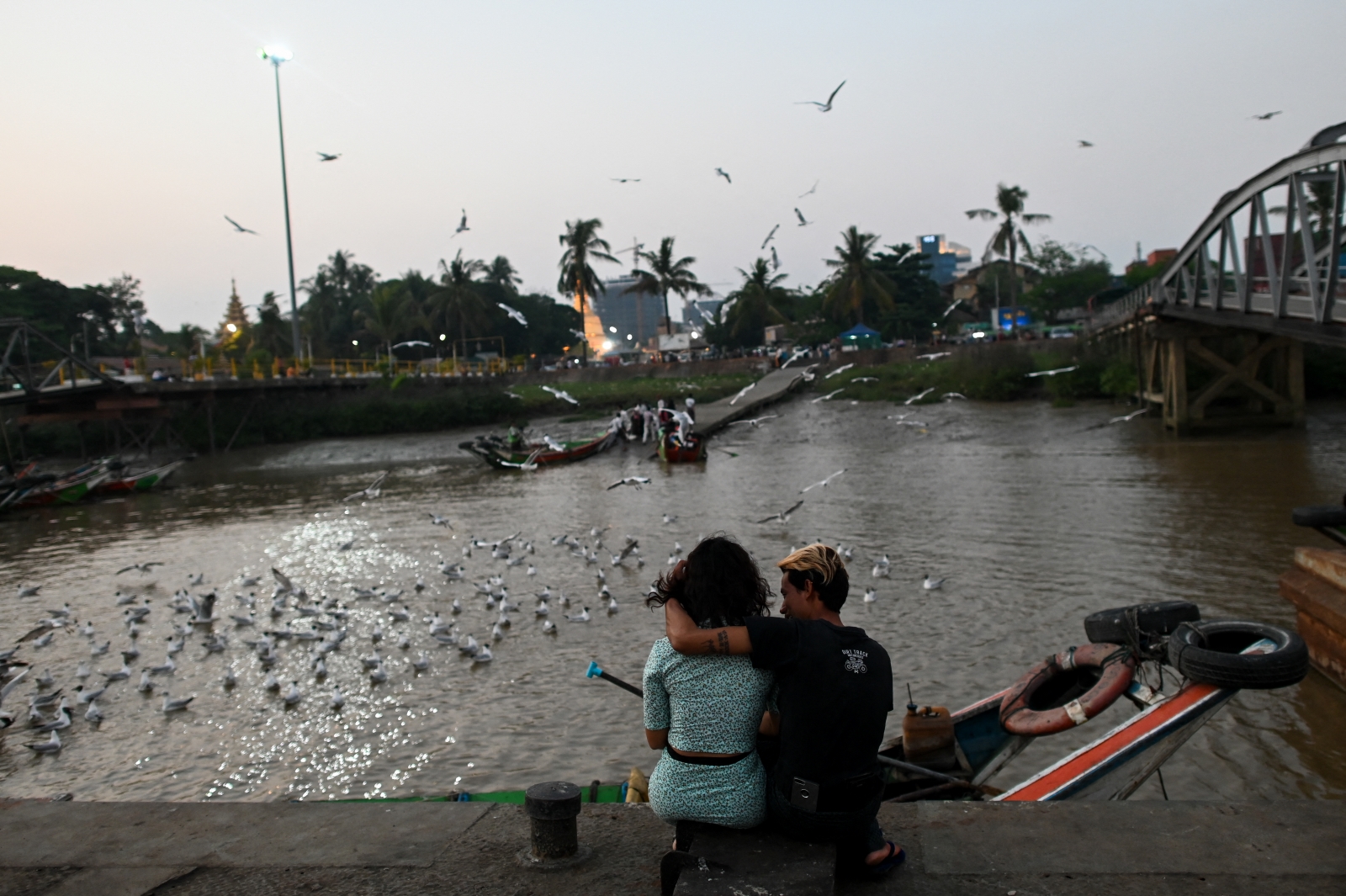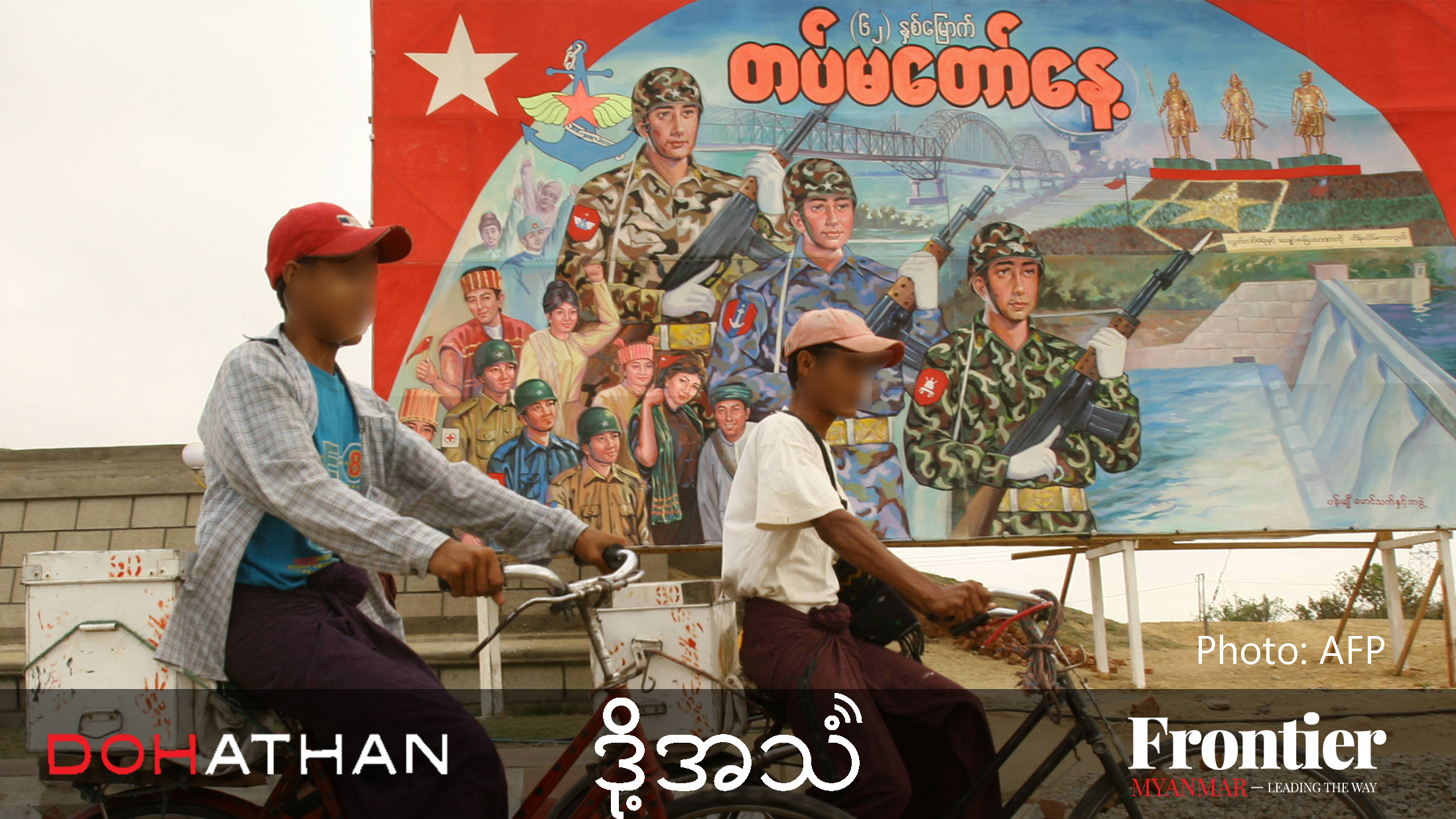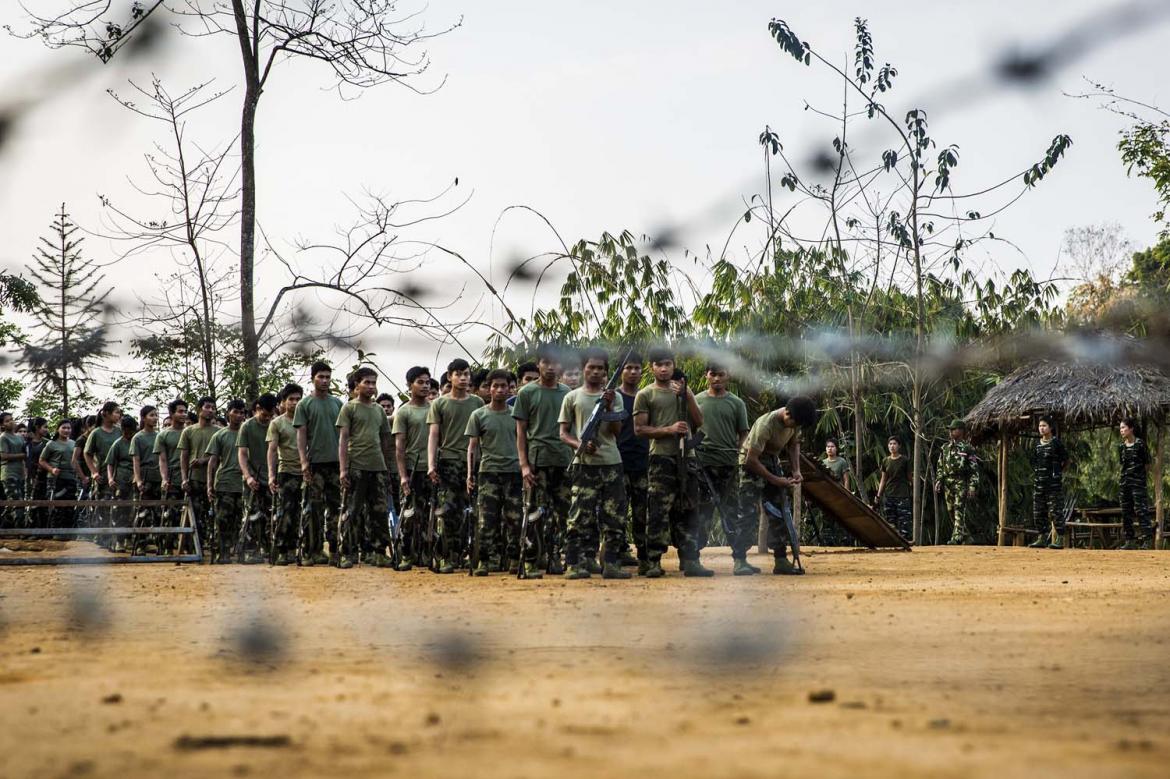Sagaing Region residents equipped with single-shot traditional rifles known as “tumi guns” – and in some cases more modern weaponry – are resisting security forces’ attempts to crush anti-coup protests.
By FRONTIER
When the Tatmadaw staged its bloodiest single-day massacre on March 27, killing 114 people nationwide, the residents of Kalay in western Sagaing Region resolved to fight back.
That day, they formed the Kalay Civil Army and fortified themselves in the city’s Tarhan ward. They began arming themselves with local hunting rifles known as tumi guns, as well as more modern firearms.
The protest camp held for more than 10 days, even as the military sent in more and more reinforcements to the town.
On April 4, the protesters even conducted a prisoner swap, handing over seven police in exchange for nine civilians. Two days later, the military tried to negotiate with the protesters, asking them to dismantle the protest camp. Protest leaders countered that they would, if the military let them stage large demonstrations in the town. The talks ended without a deal.
The next day, the military staged an early-morning crackdown. Eleven people were killed during hours of bitter fighting in Tarhan ward, after which the protest camp was dismantled. Police and soldiers are searching for the remaining KCA members, but protest leaders say the resistance will continue.
“We formed the KCA to protect our people and our township. Members of the KCA are in a safe place and plan to return and hold talks with protesters about launching a counterattack,” said Ma Aye Thazin, a protest leader in Kalay. (Names in this story have been changed to protect the identity of protesters)
The attempts to resist the security forces in Kalay have been replicated in numerous other townships in Sagaing, which has emerged as a hotbed of armed resistance to military rule.
Since late March, residents in Tamu, Pinlebu and Taze have also waged fierce, pitched battles with police and soldiers, resulting in heavy casualties on both sides.
Unlike Yangon and Mandalay, protesters in the more remote western and northern reaches of Sagaing have access to weapons – and not just their traditional hunting rifles, swords and Molotov cocktails. Multiple sources told Frontier that protesters in Kalay, Tamu and Pinlebu had managed to acquire more modern weaponry, including in some cases assault rifles and grenades.
Other factors behind the resistance include a long tradition of pro-democracy protests and a relatively light Tatmadaw presence, owing to the lack of ethnic insurgency compared to other frontier areas.
The Sagaing capital, Monywa, along with Kalay and Depayin townships, have long been bastions of political activism, and their residents were heavily involved in the national uprising in 1988 and the monk-led protests in 2007 known as the Saffron Revolution.
In line with this tradition, Monywa has seen some of the biggest protests since February 1, despite the security forces employing brutal tactics to crush protesters’ resolve. A resident activist who asked not to be named said the protests in Monywa will not stop until the military is removed from power.
“If we stop protesting in Monywa town, they [the military] will focus on smaller and less-populated townships in Sagaing Region,” the protester said, adding that more troops would likely be sent to the region now large-scale protests in Yangon and Mandalay were becoming rare.
Aye Thazin, the protest leader from Kalay, agreed, telling Frontier that the security forces had not been able to focus much attention on Kalay and Tamu, a town on the border with India, while protests continued in Monywa.
In Tamu, protesters have inflicted relatively heavy casualties on the security forces. Ko Min Thu, a protest leader, confirmed to Frontier that residents were resisting with modern and traditional guns, as well as grenades, and had so far killed at least 10 members of the security forces.
“If we don’t shoot back at them, the protesters will be killed easily and protests will disappear in our township,” he said, adding that armed resistance was occurring in both rural and urban areas.
The first major attack in Tamu came on April 1, when a policeman who had defected to the Civil Disobedience Movement led residents in a hand grenade attack on the rural Nan Phar Lone police outpost, leaving up to six police dead. The renegade policeman was killed during the attack, Min Thu said.
Three days later, a hand grenade was lobbed into a military vehicle in Tamu town, killing another four soldiers.
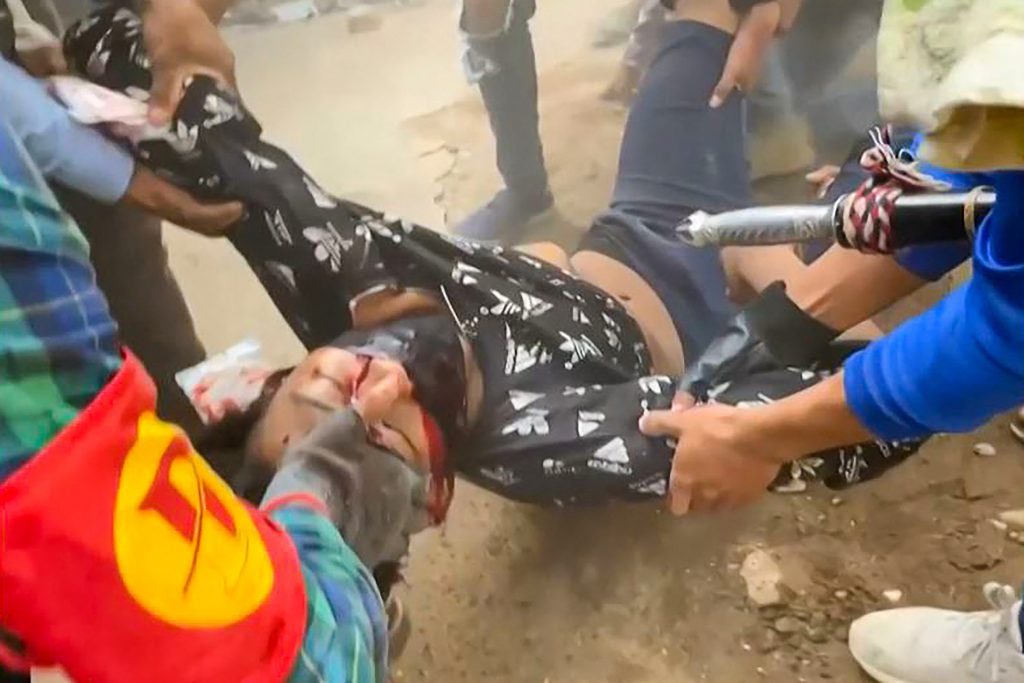
Min Thu said fighting back against the security forces had helped to keep casualties low among protesters in Tamu, where the number of fatalities stood at six as of April 12.
“That’s why protesters in other places need to fight back against police and soldiers without fear,” said. “Police and soldiers must fear the people.”
But Tamu’s position on the border provides protesters with advantages that their counterparts elsewhere lack.
Tamu resident and protest leader Ko Sithu told Frontier that anyone injured there could be taken across the nearby Indian border to Moreh in Manipur for treatment. If the situation in Tamu deteriorated residents could also flee across the border, he said.
Although he refused to speak in detail about where protesters had acquired their weapons, he said that it was possible to buy them in the area because there are numerous insurgent groups along the Myanmar-India border.
“Because we are in a border township, we don’t need to worry about accessing weapons,” he said. “But I don’t know how long we can defend against the police and soldiers.”
The armed resistance among some protesters has prompted warnings that Myanmar may be sliding towards an expanded civil war, but Sithu said that demonstrators were just responding to the brutality of the security forces.
“We want to protest peacefully and weapons are only for self-defence,” he added. “I want to be clear that if we had a choice then we would not be using weapons.”
Meanwhile, in Pinlebu in northern Sagaing, at least two police officers were fatally injured by tumi guns in a confrontation with residents on April 5, when the township General Administration Department office was set on fire. At least four protesters were also killed.
By the time of the clash most residents had already fled the town, leaving behind only a core of armed protesters, said Ko Thiha.
“We have only tumi guns for resistance and we are calling the current situation the ‘Tumi Revolution’. Kalay and Tamu are also resisting with firearms, including tumi guns,” he said.
The town of Gangaw in Magway Region is a three-hour drive from Kalay, at the southern end of the same remote valley wedged between two mountain ranges. Protesting villagers there have also used tumi guns to defend themselves against security forces, clashing on March 30.
“We used tumi guns for self-defence. The police are afraid of guns and do not dare shoot indiscriminately at the people because they know the people will shoot back,” said Ko Aung Htoo, a resident of the town’s Myoma ward.
Since April 2, most residents of Myoma and Moe Kaung wards in the town have moved elsewhere after police and soldiers began searching their houses for weapons. The residents were worried about being arrested even if no weapons were found.
Magway Region Hluttaw MP-elect U Kyaw Kyaw Tun (National League for Democracy, Gangaw-2) said he had relocated after police and soldiers were deployed in the wards.
“Only their [security forces] people are still in Myoma and Moe Kaung wards. The residents have fled to Chin State or other townships [in Magway Region],” he said, adding that four people in Gangaw were killed by the security forces in the last week of March.
Despite recent crackdowns in Tamu, where security forces attacked with live rounds and hand grenades on April 10, killing three people, residents are determined to keep up their armed struggle and have formed the “Tamu Security Group”.
Ko Min Thu said they would continue to resist with their makeshift arsenal of tumi guns, AK47 and M16 assault rifles and hand grenades, but would adopt new hit-and-run tactics to make life difficult for the security forces.
“Soon we will fight back with a guerrilla strategy,” he said. “We have fewer members than the security forces, so we need to change tactics.”


